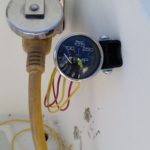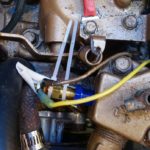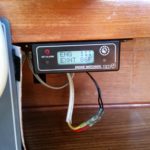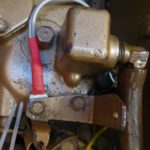But we don’t… like it hot, that is… if we did, we’d cruise somewhere warmer, like Mexico or the Caribbean. But right now we’re not even cruising the Pacific Northwest, so you the poor reader is stuck with another gear / equipment review.
And (wait for the segue), what likes heat even less than us? Our venerable Universal 5432 / Westerbeke M40 diesel engine. After our scare with the fresh water pump, where we count ourselves extremely lucky not to have overheated and a) damaged the engine and/or b) drifted into the rocks outside Roche Harbor on the ripping 4 knot current in the Spieden Channel, we figured it was high time to confront a few issues with the stock temperature monitoring setup.
On our Gulf 32 (and most others, we gather), there are two main issues with trying to keep a close eye on engine temperature: First off, all of our engine gauges are down below, in the pilothouse… nifty when steering from below, but useless when up in the cockpit. Second issue, one that’s not specific to our boat or Gulf 32’s in general, is that traditional temperature gauges – where a sender is reading the temperature of the coolant as it circulates past – can miss overheating that coincides with loss of coolant… coolant drops (for whatever reason), no more coolant flowing past the temperature gauge sender, no accurate readings of engine temp. Before our quick lap to Sucia last June we tried to (hopefully) remedy both of these problems.
For issue number one, the simple solution (hah, like there are simple solutions on boats) was to install a second temperature gauge in the cockpit. After much researching, we figured best route was to simply replicate the 2″ Faria gauge we have in the pilothouse and mount another one in the cockpit. The big trick here (other than figuring out the wiring, which was pretty straightforward) was to realize that you need a different sender if you’re going to run two gauges. Sender technology (I use that word loosely as this “tech” has been around a looonnnngggg time) is based on resistance in the circuit from gauge through the sender to ground… if you have two gauges instead of one sending power through a sender it has to be ready for that or else readings will be way off. Of course, nothing’s totally straightforward… Faria no longer makes (never made?) a 1/4″ NPT dual sender… the threaded hole for the sender in our thermostat housing is 1/4″ NPT, and you need to stick with the same manufacturer across senders and gauges or you’ll get false readings. Brian on Aeolus (http://gulf32aeolus.blogspot.com) drilled and tapped his thermostat housing out to 3/8″ NPT and found many senders available at that size… being timid, and not owning a 3/8″ tap and die set, we went the other direction… simple aluminum adapter that is 1/4″ NPT male (screwing in to the thermostat housing) and 1/8″ NPT female (which sender screws in to), allowing us to use a readily available Faria dual sender that was 1/8″ NPT threaded. The adapter makes the new sender stick out a bit so padded it best we could and will keep an eye on it to make sure it’s not chafing the cooling hose.
With the sender figured out, the rest of the work was mostly electrical and pulling wires. As far as the wiring scheme, we chose this time to add a small fuse block that – through a relay – is only energized when the key is on… a little overkill for this one project, but will come in handy down the road if we add more “only when the ignition is on” devices. With that block installed, wires were pulled to the stern locker and run through a conveniently existing grommet and wired to the new gauge. With the gauge mounted in an easily sourced bracket and bolted to the front wall of the stern locker, we were good to go! Quick test run and it shows the same temperature as the gauge in the pilothouse, so now we can see engine temperature without sticking our head down below… very reassuring. To prevent damage / UV abuse to the gauge when not in use, we went with the ubiquitous empty peanut butter jar, painted white, jammed over the top… CLASSY!!
But, the-lone-reader-who-made-it-this-far asks, what if your coolant disappears (boils off, leaks, etc)? You still have the same problem. True indeed, so the other product we’re employing now is the Engine Watchdog, a trick little device made in Australia. Available in various forms (single sensor, dual sensor, etc.), we went with the Engine Watchdog TM4 with custom labeling. It came quickly and as advertised, even with overseas shipping. What we got was a small display that shows temperatures of two sensors, which we had labeled “ENG” and “EXHT” (only four letters available), indicating our engine block temperature and the exhaust temperature. The cool thing with the Engine Watchdog is that each “sensor” is simply a ring terminal at the end of a wire, and the temperature it reads is the temperature of the ring sensor. So we threaded one in under a bolt on the head of the engine, and the other is hose clamped to the very end of the metal part of the exhaust, right before it goes into the rubber exhaust hose. The advantage here is, you get the temperature of those two locations… period… regardless of how your cooling system is or isn’t working.
Since the display is mounted in the pilothouse, we went ahead and set alarm levels for each sensor separately… if the temperature exceed the set limit, a quite loud alarm goes off from the unit in the pilothouse… for convenience, the Engine Watchdog comes pre wired with leads you can wire to a separate alarm horn, so if we find we’re missing the Watchdog’s alarm in the pilothouse (has been pretty easy to hear so far) we can always wire an additional alarm horn in the cockpit somewhere. Since our sensor mounting location choices were somewhat arbitrary, we just monitored the temps very closely for a while and figured once we were at a point of “fully warm” we’d set the alarms a bit above that level. Motoring into the current and into the wind down the Hale Passage seemed to qualify as “fully warm engine” so we used numbers a bit above the max we saw there, which was 154F for the engine block sensor and 100F for the exhaust.
Both setups got good use during our short trip to Ewing on Sucia and it is a huge relief to a) be able to watch our temp all the time when in the cockpit and b) know there’s an alarm watching out for us as well, for those inevitable (long) moments of inattention. Gauges are gauges so go with what’s going to work for your existing setup, but so far I would have no qualms about heartily recommending the Engine Watchdog as a secondary stand alone monitor.
One other small addition (it’s so easy to setup I hesitate to call it a modification) worth mentioning are two simple little items from Snapit Products. We ordered and installed their Binnacle Mounted Drink Holder and Winch Handle Pocket. For relatively inexpensive, generic plastic items, they’ve both been great additions. The cup holder works for coffee cups and binoculars under way, and is an easy spot to clip the portable VHF in the cockpit… and of course, once at anchor, it seems to hold adult beverages just fine too. And having an easy to grab winch handle not stashed in some cockpit coaming side pocket is much quicker. After looking at the prices for some cockpit tables / drink holders, all teaked up and varnished to a high shine, we’ve been very happy with Snapit’s bang for the buck.
Stay tuned for some more actual sailing this fall, but that’s the state of the upgrades for now!
Links for products from this post:
Faria Gauge: http://fariabeede.com/products.php?calledGauge=2_temp
1/4″ to 1/8″ NPT reducer: http://www.ebay.com/itm/141866559006
Faria 1/8″ NPT American Dual Sender Part #90406: http://www.ebay.com/itm/252414941357
2″ gauge mounting cup: https://www.amazon.com/Auto-Meter-2203-Mounting-Cup/dp/B00062YVF2
Engine Watchdog: http://enginewatchdog.com/TM4-twin-custom-order.html
Snapit Binnacle holder: http://snapitproducts.com/snapit-marine/products/m0023/m0023-binnacle-mounted-drink-holder
Snapit Winch Pocket: http://snapitproducts.com/snapit-marine/products/m008/m008-winch-handle-pocket
(P.S. We have no stake in any of the products mentioned, just users and so far happy customers).





I don’t know where or how you learned to do this. Not from us, for sure (with perhaps the exception of a winch handle storage spot).
xoDebbie
I barely understood any of this coolant business. Liked the peanutbutter jar – and just love reading anything you post to your fans. Sana